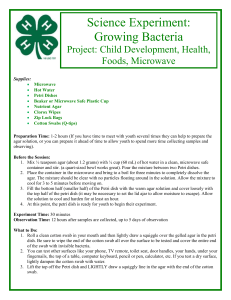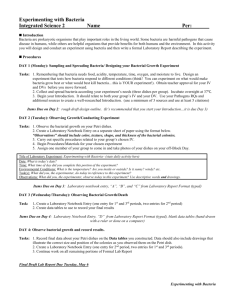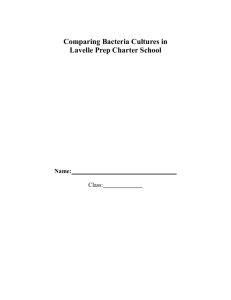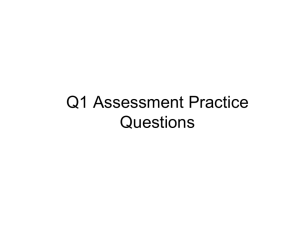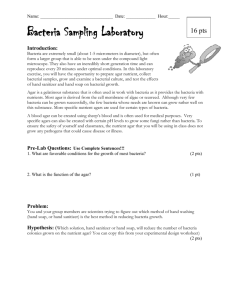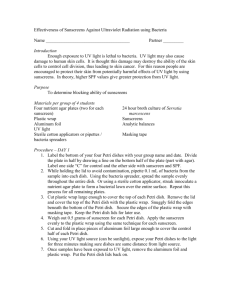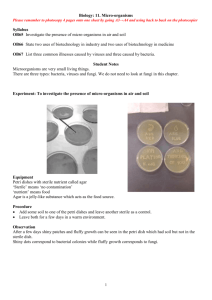How to Culture Bacteria Steps
advertisement
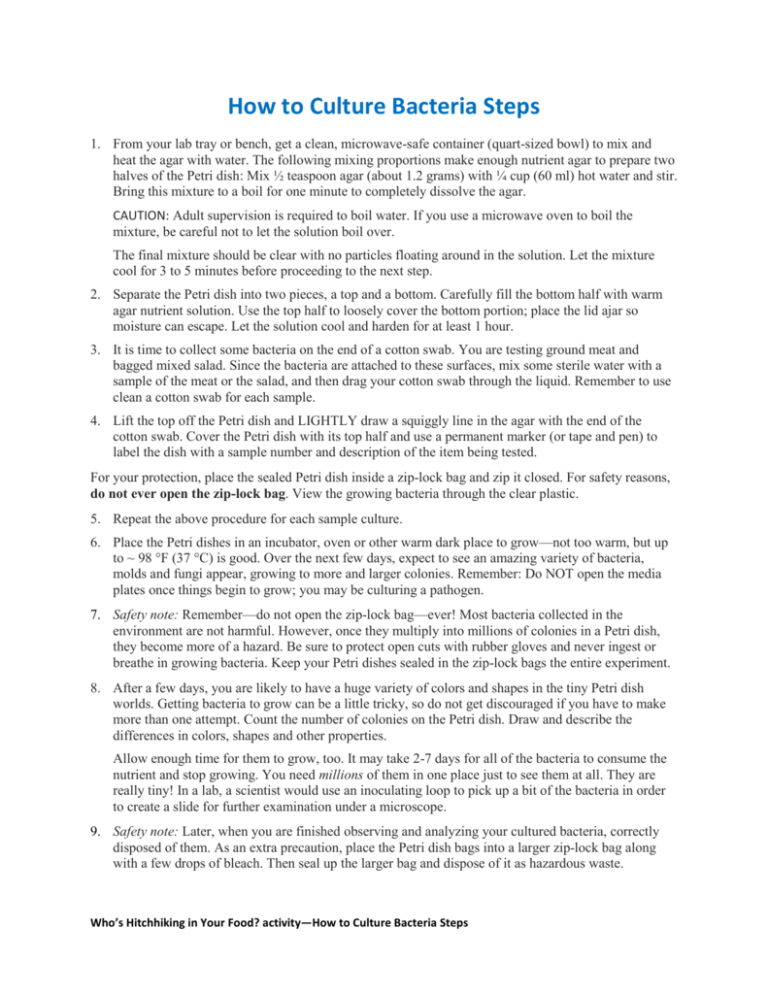
How to Culture Bacteria Steps 1. From your lab tray or bench, get a clean, microwave-safe container (quart-sized bowl) to mix and heat the agar with water. The following mixing proportions make enough nutrient agar to prepare two halves of the Petri dish: Mix ½ teaspoon agar (about 1.2 grams) with ¼ cup (60 ml) hot water and stir. Bring this mixture to a boil for one minute to completely dissolve the agar. CAUTION: Adult supervision is required to boil water. If you use a microwave oven to boil the mixture, be careful not to let the solution boil over. The final mixture should be clear with no particles floating around in the solution. Let the mixture cool for 3 to 5 minutes before proceeding to the next step. 2. Separate the Petri dish into two pieces, a top and a bottom. Carefully fill the bottom half with warm agar nutrient solution. Use the top half to loosely cover the bottom portion; place the lid ajar so moisture can escape. Let the solution cool and harden for at least 1 hour. 3. It is time to collect some bacteria on the end of a cotton swab. You are testing ground meat and bagged mixed salad. Since the bacteria are attached to these surfaces, mix some sterile water with a sample of the meat or the salad, and then drag your cotton swab through the liquid. Remember to use clean a cotton swab for each sample. 4. Lift the top off the Petri dish and LIGHTLY draw a squiggly line in the agar with the end of the cotton swab. Cover the Petri dish with its top half and use a permanent marker (or tape and pen) to label the dish with a sample number and description of the item being tested. For your protection, place the sealed Petri dish inside a zip-lock bag and zip it closed. For safety reasons, do not ever open the zip-lock bag. View the growing bacteria through the clear plastic. 5. Repeat the above procedure for each sample culture. 6. Place the Petri dishes in an incubator, oven or other warm dark place to grow—not too warm, but up to ~ 98 °F (37 °C) is good. Over the next few days, expect to see an amazing variety of bacteria, molds and fungi appear, growing to more and larger colonies. Remember: Do NOT open the media plates once things begin to grow; you may be culturing a pathogen. 7. Safety note: Remember—do not open the zip-lock bag—ever! Most bacteria collected in the environment are not harmful. However, once they multiply into millions of colonies in a Petri dish, they become more of a hazard. Be sure to protect open cuts with rubber gloves and never ingest or breathe in growing bacteria. Keep your Petri dishes sealed in the zip-lock bags the entire experiment. 8. After a few days, you are likely to have a huge variety of colors and shapes in the tiny Petri dish worlds. Getting bacteria to grow can be a little tricky, so do not get discouraged if you have to make more than one attempt. Count the number of colonies on the Petri dish. Draw and describe the differences in colors, shapes and other properties. Allow enough time for them to grow, too. It may take 2-7 days for all of the bacteria to consume the nutrient and stop growing. You need millions of them in one place just to see them at all. They are really tiny! In a lab, a scientist would use an inoculating loop to pick up a bit of the bacteria in order to create a slide for further examination under a microscope. 9. Safety note: Later, when you are finished observing and analyzing your cultured bacteria, correctly disposed of them. As an extra precaution, place the Petri dish bags into a larger zip-lock bag along with a few drops of bleach. Then seal up the larger bag and dispose of it as hazardous waste. Who’s Hitchhiking in Your Food? activity—How to Culture Bacteria Steps


